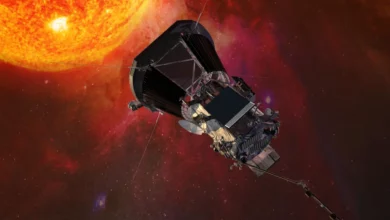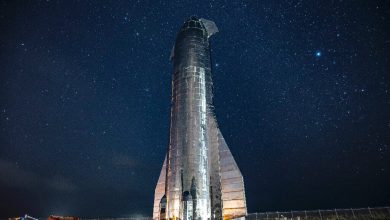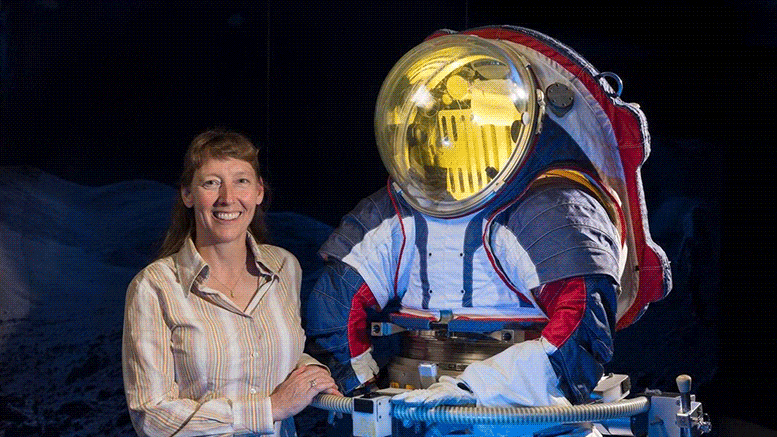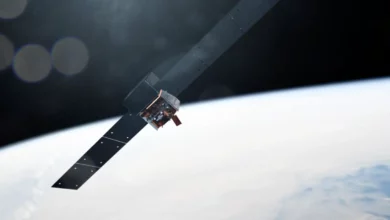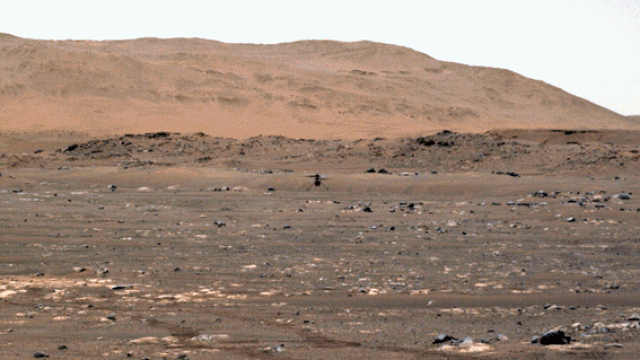
Back on 19th April, NASA’s Ingenuity helicopter made the first-ever powered flight on a world beyond Earth.
Here’s how it all went down during their first flight…
The 4-lb. (1.8 kilograms) chopper was scheduled to rise from the floor of Mars’ Jezero Crater at 12:31 a.m. EDT (0431 GMT), get a maximum of 10 feet (3 meters) above the red dirt and land after roughly 40 seconds aloft.
At about 6:15 a.m. EDT (1015 GMT), data came down from Ingenuity — via its much larger partner, NASA’s Perseverance rover — that the little rotorcraft had hit its marks. The first photo from Ingenuity showed the helicopter’s shadow on the Martian surface below, while Perseverance captured stunning video of the historic flight on Mars.
“Ingenuity has performed its first flight, the first flight of a powered aircraft on another planet!” Ingenuity’s chief pilot Håvard Grip said as he confirmed telemetry at NASA’s Jet Propulsion Laboratory in Pasadena, California.
Brief though the flight was, it was completely game-changing, paving the way for extensive exploration by Martian aircraft down the road. Thanks to Ingenuity’s groundbreaking work, future Red Planet missions could commonly include choppers as scouts for rovers or data collectors in their own right, NASA officials said.
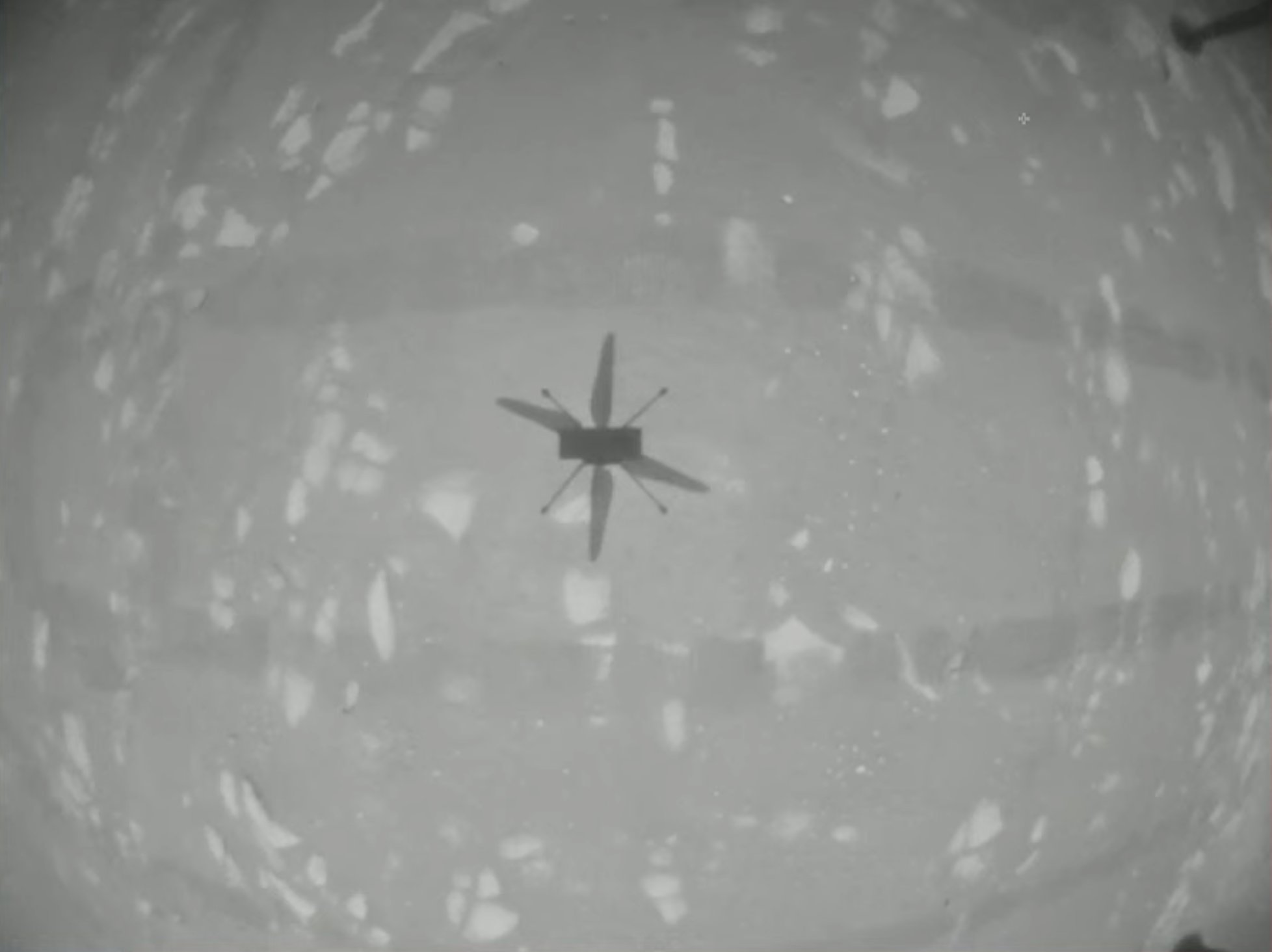
The core team behind Ingenuity’s pioneering flight watched today’s Mars flight from a control room at NASA’s Jet Propulsion Laboratory in Pasadena, California. They stood, threw up their hands and cheered as the flight’s success was confirmed.
MiMi Aung, Ingenuity’s project manager, triumphantly tore up her contingency speech (written in case of a failure) and hailed Ingenuity’s historic feat on Mars. Every planet, she’s said in the past, gets only one first flight.
“We can now say that human beings have flown a rotorcraft on another planet!” Aung said as her team cheered. “We’ve been talking so long about our Wright brothers moment on Mars, and here it is.”
NASA named Ingenuity’s Martian airfield Wright Brothers Field after Orville and Wilbur Wright, who performed the first heavier-than-air flight on Earth in 1903. There’s also a piece of their Wright Flyer plane on Ingenuity to mark the event.
Because of COVID-19 pandemic restrictions, much of Ingenuity’s mission team watched today’s event via a WebEx video conference. Aung sent them all remote hugs of success.
“You know I’m hugging you virtually,” Aung told her team.
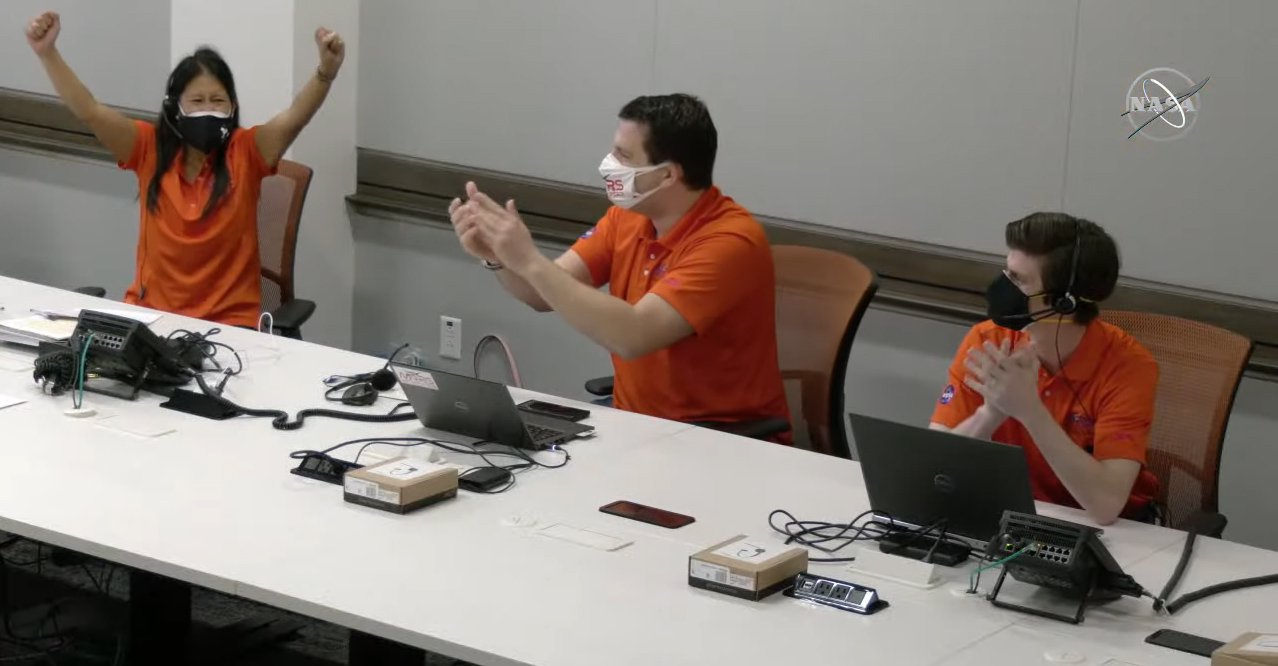
Pioneering Martian flight
Ingenuity’s $85 million mission is a technology demonstration, designed to show that powered, controlled flight is possible on the Red Planet.
This was far from a given; the Martian atmosphere is just 1% as dense as that of Earth at sea level, so there’s not much air for helicopter blades to push against. This disadvantage outweighs the benefits that aircraft gain from Mars’ lower gravitational pull, which is just 38% as strong as Earth’s.
Ingenuity flew to Mars attached to the belly of Perseverance, landing inside Jezero with the $2.7 billion rover on Feb. 18. Early this month, the solar-powered rotorcraft deployed onto the crater floor and began prepping for its historic month-long flight campaign, which was originally supposed to begin on April 11.
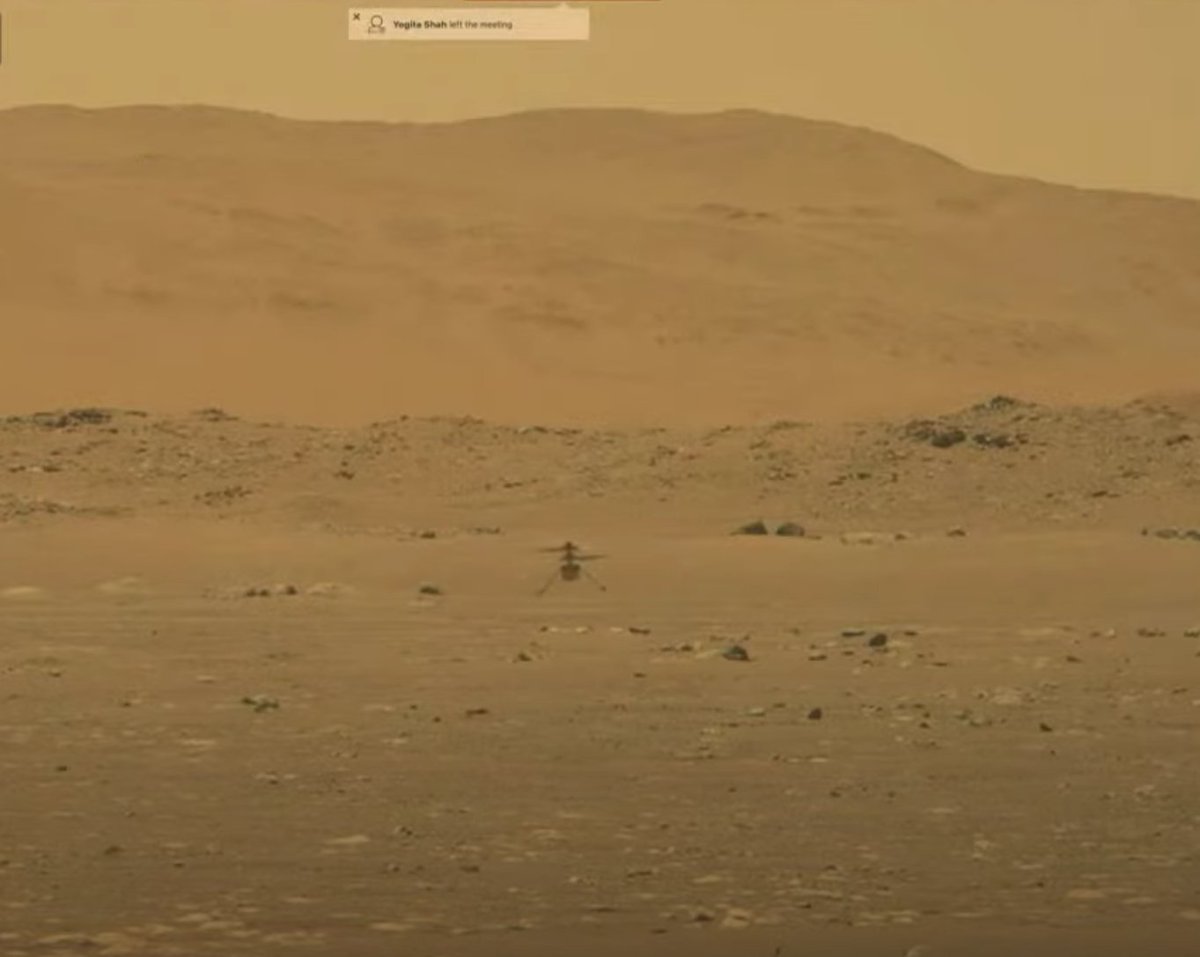
That campaign is not focused on gathering data; it’s meant only to prove that the feat is possible. Ingenuity carries no scientific instruments, though it is equipped with a black-and-white navigation camera and a 13-megapixel color imager.
The 19-inch-tall (48 centimeters) helicopter sailed through its preflight checks until the final one, an attempted high-speed spin test of the craft’s twin, 4-foot-long (1.2 m) rotors on April 9. Those carbon-fiber blades were supposed to spin at about 2,400 revolutions per minute — the rotational velocity they achieve during operational flight — while Ingenuity remained on the ground. But the chopper suffered an issue with its “watchdog timer” and failed to transition into flight mode as required by the test.
The mission team initially pushed the flight back to April 14, then delayed it again to troubleshoot the issue further. On Saturday (April 17), Aung announced that the team was confident it had found a fix — an adjustment of the command sequence beamed from Earth — and set today as the targeted first-flight date.
They made a video of the first lift up on the red planet
“This solution is the least disruptive to a helicopter that, up until we identified the watchdog issue, has been behaving just as we expected,” Aung wrote in a blog post Saturday. “It is the most straightforward, since we do not have to change its configuration.”
The fix was effective, as this morning’s flight shows. Ingenuity flew as planned with the modified command sequence, becoming the first robot ever to ply Mars’ thin, dusty skies.
Don’t assume from this focus on commands, however, that Ingenuity is a mindless drone; the little robot is capable of significant autonomy. For example, Ingenuity gets its bearings during flight in real time by analyzing the photos snapped by its navigation camera.
Preparations were made for the second flight
“History does tell us that soon after their first flight, Orville and Wilbur did go right back to work,” Aung said today of the Wright Brothers’ famous experiment at Kitty Hawk, North Carolina, on Dec. 17, 1903. They flew three more times that day, each one higher and farther than the last, she added.
“This is just the first great flight,” Aung said. “Congratulations, take a moment and then let’s get back to work!”
Second flight attempt
NASA’s little Ingenuity helicopter took to the skies above Mars’ Jezero Crater again early this morning (April 22), just three days after making history with the first powered, controlled flight on a world beyond Earth.
Monday’s landmark 39-second debut flight was a straight up-and-down trip that took Ingenuity just 10 feet (3 meters) off Jezero’s dusty floor. The helicopter team pushed the 4-lb. (1.8 kilograms) rotorcraft a little harder during today’s 52-second sortie, which lifted off at 5:33 a.m. EDT (0933 GMT).
“Go big or go home! The Mars Helicopter successfully completed its 2nd flight, capturing this image with its black-and-white navigation camera,” officials with NASA’s Jet Propulsion Laboratory in Southern California wrote on Twitter. “It also reached new milestones of a higher altitude, a longer hover and lateral flying.”
Today’s flight plan called for Ingenuity to climb to 16.5 feet (5 m), hover, tilt slightly and move sideways for 6.5 feet (2 m), Ingenuity project manager MiMi Aung, of NASA’s Jet Propulsion Laboratory in Southern California, wrote in a preflight blog post (April 21).
“Then Ingenuity will come to a stop, hover in place and make turns to point its color camera in different directions before heading back to the center of the airfield to land,” Aung wrote.
NASA’s Perseverance rover watched all of today’s aerial action from about 210 feet (64 m) away, just as it did on Monday. Imagery and other data captured by the six-wheeled robot started coming down to Earth at 9:20 a.m. EDT (1320 GMT), agency officials said.
Ingenuity is a technology demonstration designed to show that aerial exploration is feasible on the Red Planet despite the thin atmosphere of Mars. Helicopters could become common elements of Red Planet missions in the future thanks to Ingenuity’s pioneering work, NASA officials have said.
The little chopper and Perseverance landed together on Feb. 18. On April 3, Ingenuity deployed from the rover’s belly and began prepping for its month-long flight campaign.
Aung and her team plan to conduct three more flights in the two weeks they have left. These sorties will get progressively more complex and ambitious, and the final two will likely be “really adventurous,” Aung said during a news conference earlier this month.
Perseverance is supporting Ingenuity’s efforts, serving as a communications relay between the solar-powered helicopter and its handlers here on Earth. The rover is also documenting the historic aerial campaign, as the amazing video of Ingenuity’s first flight shows.
But Perseverance needs to start focusing on its own mission soon, which is why Ingenuity’s flight campaign must come to an end in early May. The rover will hunt for signs of ancient Mars life in Jezero, which hosted a big lake and a river delta long ago, and collect samples for future return to Earth.
Perseverance also carries another technology demonstration: an instrument called MOXIE (“Mars Oxygen In-Situ Resource Utilization Experiment”) that generates oxygen from the carbon dioxide-dominated Martian atmosphere.
Scaled-up versions of MOXIE could help human explorers get a foothold on the Red Planet, NASA officials have said. And that dream got a little closer to reality on Tuesday (April 20), when MOXIE produced oxygen for the first time.
Third flight attempt
The 4-lb. (1.8 kilograms) chopper aced its third-ever Martian flight early this morning (April 25), adding to its already impressive resume.
“Third flight in the history books.” officials at NASA’s Jet Propulsion Laboratory in Southern California wrote on Twitter. “Our #MarsHelicopter continues to set records, flying faster and farther. The space chopper is demonstrating critical capabilities that could enable the addition of an aerial dimension to future missions to Mars & beyond.”
And today’s sortie was significantly more complex than Ingenuity’s previous two flights, which took place on Monday (April 19) and Thursday (April 22), respectively. On its historic, 39-second debut hop — the first powered, controlled flight for an aircraft on a world beyond Earth — the solar-powered helicopter went straight up and down and reached a maximum altitude of about 16.5 feet (5 meters).
Ingenuity went about that high on flight number two but stayed up for nearly 52 seconds and moved side-to-side a total of 13 feet (4 m).
“For the third flight, we’re targeting the same altitude, but we are going to open things up a bit, too, increasing our max airspeed from 0.5 meters per second to 2 meters per second (about 4.5 mph) as we head 50 meters (164 feet) north and return to land at Wright Brothers Field,” Ingenuity chief pilot Håvard Grip, of NASA’s Jet Propulsion Laboratory (JPL) in Southern California, wrote in a blog post Friday (April 23). (The Ingenuity team named the chopper’s flight zone after aviation pioneers Wilbur and Orville Wright.)
“We’re planning for a total flight time of about 80 seconds and a total distance of 100 meters (330 feet),” he added.
At around 10:15 a.m. EDT (1415 GMT) today, data began streaming in to mission control at JPL confirming that Ingenuity had executed those commands successfully.
Communications to and from Ingenuity are relayed via NASA’s Perseverance rover, which is serving a key support and observation role for the helicopter. The two robots landed together inside Mars’ 28-mile-wide (45 kilometres) Jezero Crater on Feb. 18, and Ingenuity deployed from the car-sized rover’s belly on April 3, kicking off the current month-long flight campaign.
That campaign is designed to show that aerial exploration is possible on Mars, which has an atmosphere just 1% as dense as that of Earth at sea level. Ingenuity’s success could pave the way for the extensive use of rotorcraft on future Red Planet missions, with Mars helicopters serving as scouts for rovers and also gathering data themselves, NASA officials have said.
More flights on the horizon before starting Mars exploration
The Ingenuity team hopes to fly two more times before the flight window closes in early May. And these last two sorties will likely be “really adventurous,” Ingenuity project manager MiMi Aung, also of JPL, said during a news conference earlier this month, stressing that she and her colleagues want to push the little aircraft’s limits.

